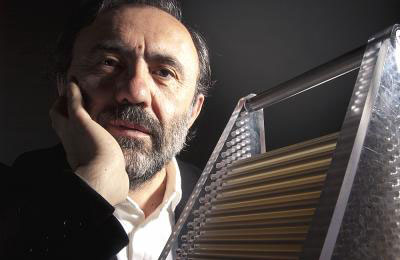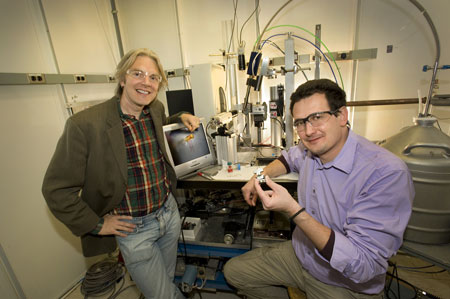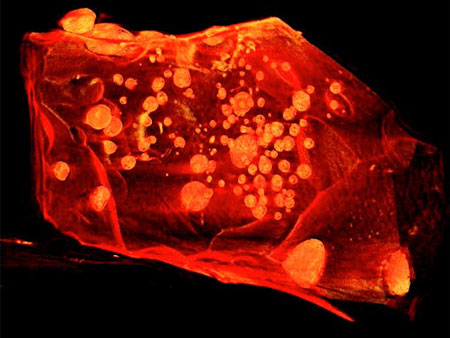Quantum or not?
 Mathematical equations can now resolve whether electron transport in nanostructures follows classical or quantum mechanical behavior.
Mathematical equations can now resolve whether electron transport in nanostructures follows classical or quantum mechanical behavior.
Dec 17th, 2010
Read more
 Mathematical equations can now resolve whether electron transport in nanostructures follows classical or quantum mechanical behavior.
Mathematical equations can now resolve whether electron transport in nanostructures follows classical or quantum mechanical behavior.
Dec 17th, 2010
Read moreThe standard approach to cancer therapy today is to mix and match chemotherapy drugs in order to attack tumors in multiple ways. Now, two separate teams of investigators have demonstrated that using nanoparticles to deliver multiple drugs simultaneously can produce a synergistic effect that boosts the cell-killing ability of both drugs.
Dec 16th, 2010
Read moreResearchers at Rice University, collaborating with investigators at the Baylor College of Medicine, have used two different types of imaging technologies to track the delivery of a therapeutic nanoparticle to breast tumors.
Dec 16th, 2010
Read moreResearchers at the University of Illinois, Urbana-Champaign, have developed a new kind of microsensor to answer one of the weightiest questions in biology - the relationship between cell mass and growth rate.
Dec 16th, 2010
Read moreEmploying nanoparticles as a drug delivery agent, a research team has created a 'nanobioconjugate' drug that may be given by intravenous injection and carried in the blood to target the brain tumor.
Dec 16th, 2010
Read moreA porous, disk-shaped "nest" for nanotubes may help magnetic resonance imaging become better than ever at finding evidence of cancer if the results of research led by investigators at Rice University are any indication of future success.
Dec 16th, 2010
Read moreResearchers in Japan have developed a silicon nitride ceramic material which displays significantly higher resistance to thermal shocks and strength at high temperatures than conventional silicon nitride ceramics.
Dec 16th, 2010
Read more Advancements in fabrication technologies may lead to superlenses and other designer optical materials, according to an Iowa State University and Ames Laboratory physicist.
Advancements in fabrication technologies may lead to superlenses and other designer optical materials, according to an Iowa State University and Ames Laboratory physicist.
Dec 16th, 2010
Read moreUniversity of Utah physicists stored information for 112 seconds in what may become the world's tiniest computer memory: magnetic 'spins' in the centers or nuclei of atoms. Then the physicists retrieved and read the data electronically - a big step toward using the new kind of memory for both faster conventional and superfast quantum computers.
Dec 16th, 2010
Read moreResearchers pave the way for spin computers.
Dec 16th, 2010
Read morePhysicists from the Max Born Institute in Berlin have now returned to the use of electrons in holography. A special element in their approach is that the electrons that image the object are made from the object itself using a strong laser.
Dec 16th, 2010
Read more Newly discovered phase helps explain materials' ability to convert waste heat to electricity.
Newly discovered phase helps explain materials' ability to convert waste heat to electricity.
Dec 16th, 2010
Read more A new method of capturing detailed, three-dimensional images of minute samples of material under extreme pressures is shedding light on the evolution of the Earth's interior. Early results suggest that the early Earth did not have to be entirely molten to separate into the rocky crust and iron-rich core it has today. Researchers at Stanford University and SLAC National Accelerator Laboratory are leading the group pioneering the technique, which could lead to a wide range of new experiments.
A new method of capturing detailed, three-dimensional images of minute samples of material under extreme pressures is shedding light on the evolution of the Earth's interior. Early results suggest that the early Earth did not have to be entirely molten to separate into the rocky crust and iron-rich core it has today. Researchers at Stanford University and SLAC National Accelerator Laboratory are leading the group pioneering the technique, which could lead to a wide range of new experiments.
Dec 16th, 2010
Read moreIn 2009, the journal Nature Physics called it the 'Ionization Surprise'. Where it had been commonly thought that the ionization of atoms by strong laser fields was meanwhile well-understood, novel experiments where rare gas atoms were ionized using relatively long (few-micrometers) wavelength laser light suddenly revealed an unexpected and universal low-energy feature that defied explanation. Now, scientists in Germany provide an explanation.
Dec 16th, 2010
Read moreDie Deutsche Forschungsgemeinschaft foerdert ein Projekt der Fachhochschule Giessen-Friedberg mit 210.000 Euro. Eine von Prof. Dr. Alexander Kloes geleitete Gruppe arbeitet an der 'strukturnahen Modellierung von Nanoscale Multiple-Gate-FETs zur Schaltungssimulation'.
Dec 16th, 2010
Read more SPM studies can help engineer novel techniques to reduce friction between surfaces at the molecular level and further miniaturise electronics.
SPM studies can help engineer novel techniques to reduce friction between surfaces at the molecular level and further miniaturise electronics.
Dec 16th, 2010
Read more